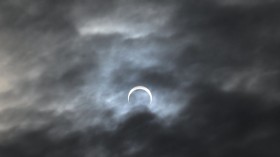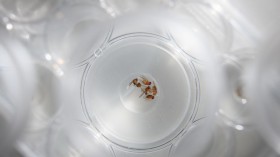The official announcement of the initiative, which comes more than a decade after the nuclear tragedy, would be another setback for Fukushima's fishing industry, which has long protested the move.
A Practical Solution
The government had agreed that dumping the water into the Pacific Ocean was the "most practical" solution and "unavoidable to achieve Fukushima's recovery," Prime Minister Yoshihide Suga told a meeting of ministers on Tuesday.
Tritium, a radioactive element that is not toxic in limited doses, cannot be eliminated from the water, according to the plant's operator, Tokyo Electric Power [Tepco], and government authorities, but other radionuclides can be lowered to quantities that are safe for release.
"After maintaining the water's quality conditions, the Japanese government has compiled specific policies for releasing the treated water into the ocean... "At the same time, the government is taking steps to protect its reputation," Suga told reporters.
Related Article: Manatee County, Florida Under State of Emergency for Possible Radioactive Flood After Phosphate Plant Leak
Action Plan
According to the government, work on releasing the diluted water will begin in about two years, with the whole project estimated to take decades.
"We choose oceanic release based on strict adherence to existing regulatory standards," it said in a statement.
Environmentalists were quick to oppose the decision.
Greenpeace Japan said the water release was "strongly opposed" because it "absolutely disregards the human rights and interests of the citizens of Fukushima, Japan, and the Asia-Pacific region."
Kazue Suzuki, the group's environment and energy activist, said, "The Japanese government has once again disappointed the citizens of Fukushima."
"The government's decision to intentionally contaminate the Pacific Ocean with hazardous waste is entirely unjustified. It has dismissed the dangers of radiation and ignored the compelling proof that ample disposal space exists in the nuclear facility and in the nearby areas.
"The cabinet's decision failed to protect the environment and ignored the widespread resistance and fears of Fukushima residents as well as civilians in Japan."
A total of 1.25 million tons of water was collected at the nuclear facility, crippled when a tsunami in 2011 caused it to break down.
Water used to cool the farm and rain and groundwater that seeps in regularly are also included. Until being released, the water will be purified again to eliminate radioactive isotopes and diluted to meet international requirements, according to the government.
The radioactive water, which increases at a rate of around 140 tons per day, is now being contained in over 1,000 tanks, with capacity at the site predicted to run out by next fall. Tepco has claimed that if it has to keep adding more storage tanks at the facility, it will fail to decommission the factory.
Scientifically Approved Method
The International Atomic Energy Agency backs the decision because radioactive materials would be eliminated from the water or lowered to acceptable levels before discharge. IAEA has already stated that nuclear power plants worldwide use a standard method to dispose of wastewater.
According to experts, tritium is toxic to humans in high doses, and processed water faces no biologically observable danger after dilution.
Before the decision, Michiaki Kai, a radiation risk management specialist at Japan's Oita University of Nursing and Health Sciences, told Agence France-Presse, "There is agreement among scientists that the effect on health is minuscule."
Possibly Harming a Market
Yes, the method is approved by science but, on the other hand, local fishing groups claim that releasing the water would reverse years of hard work to re-establish market trust in their catch.
Also Read: A Study on Plutonium Clarifies the Distinction Between Nuclear Pollution from a Global Fallout
For more environmental news, don't forget to follow Nature World News!
© 2024 NatureWorldNews.com All rights reserved. Do not reproduce without permission.





